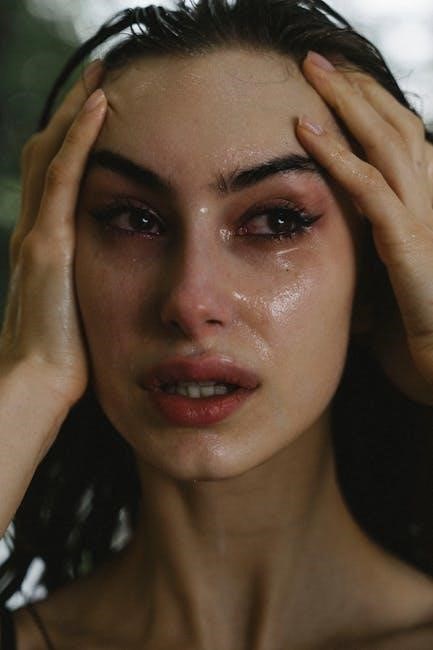
The Drama Triangle, developed by Stephen Karpman, outlines three roles—Victim, Rescuer, and Persecutor—that people adopt in dysfunctional interactions. It helps identify and transform these patterns for healthier communication and relationships.
1.1 Definition and Origin
The Drama Triangle, introduced by Stephen Karpman in 1968, is a psychological model that illustrates three dysfunctional roles people assume in conflict situations: Victim, Rescuer, and Persecutor. Rooted in Transactional Analysis (TA), a theory developed by Eric Berne, the Drama Triangle explains how individuals engage in emotional games driven by guilt, blame, and manipulation. Karpman’s concept helps identify and transform these harmful interaction patterns, fostering healthier communication. The model is widely used in psychotherapy, counseling, and personal development to understand and break free from repetitive, emotionally draining cycles.
1.2 Key Concepts and Relevance
The Drama Triangle highlights three core roles—Victim, Rescuer, and Persecutor—that individuals often unconsciously adopt in interpersonal conflicts. These roles create a cycle of blame, guilt, and manipulation, preventing genuine resolution. The model emphasizes how these patterns perpetuate emotional distress and hinder healthy communication. Its relevance lies in its ability to uncover underlying dynamics in relationships, enabling individuals to recognize and break free from destructive cycles. By understanding these roles, people can adopt more empowering behaviors, fostering personal growth and conflict resolution. The Drama Triangle is a valuable tool for improving emotional intelligence and nurturing healthier interactions in both personal and professional settings.

The Three Roles in the Drama Triangle
The Drama Triangle consists of three roles: Victim, Rescuer, and Persecutor. These roles create a cycle of conflict and emotional manipulation.
2.1 The Victim
The Victim is one of the three roles in the Drama Triangle, characterized by feelings of powerlessness and helplessness. They often see themselves as trapped or mistreated, blaming others for their circumstances. Victims may adopt a passive stance, seeking sympathy or rescue rather than taking responsibility. This role fosters a sense of martyrdom, as they believe they are at the mercy of external forces. The Victim role is driven by fear, inadequacy, or a lack of self-efficacy, creating dependency on others for solutions. By avoiding accountability, Victims perpetuate the cycle of drama, often unconsciously inviting Rescuers or Persecutors into their lives to fulfill the narrative.
2.2 The Rescuer
The Rescuer is another key role in the Drama Triangle, often portrayed as the helper or savior. They thrive on solving others’ problems, especially those of the Victim, and may feel a strong need to be needed. While their intentions may seem noble, Rescuers often have underlying motives, such as avoiding their own issues or gaining a sense of control. They enable the Victim’s dependency by continually offering solutions, which prevents the Victim from taking responsibility. Rescuers can also shift into the Persecutor role if they feel unappreciated or overwhelmed. Their actions, though well-meaning, perpetuate the drama cycle by reinforcing the Victim’s helplessness and the Persecutor’s dominance.
2.3 The Persecutor

The Persecutor is the third role in the Drama Triangle, often seen as the “bad guy.” They blamed, criticized, or controlled others, reinforcing their dominance; This role emerges from unresolved anger or fear of being vulnerable. Persecutors may feel justified in their actions, believing they are right, but they perpetuate the cycle of drama by reinforcing the Victim’s helplessness. Their behavior creates a sense of urgency for the Rescuer to step in, maintaining the triangle’s balance. Persecutors rarely recognize their role in the cycle, as they focus on external control rather than internal reflection.

Dynamics and Switching Roles
Individuals often shift between roles based on interactions, maintaining the drama cycle. Understanding these dynamics helps break the cycle and foster healthier communication patterns.
3.1 Role Switching in Interactions
Role switching in the Drama Triangle occurs when individuals shift between Victim, Rescuer, and Persecutor roles during interactions; For example, a Victim may become a Persecutor when feeling powerless, while a Rescuer might turn into a Victim if unappreciated. These switches maintain the drama cycle, as individuals seek temporary relief or control. Awareness of such shifts is key to breaking the pattern. Recognizing these dynamics helps individuals move beyond limiting roles and adopt healthier communication strategies, fostering genuine resolution rather than perpetuating conflict.
3.2 Cycles of Drama
The Drama Triangle creates self-reinforcing cycles of conflict, where roles of Victim, Rescuer, and Persecutor perpetuate emotional turmoil. These cycles often escalate as individuals react to each other’s actions, deepening the drama; The Victim seeks rescue, the Rescuer offers help to feel valued, and the Persecutor blames to assert control. This interplay sustains the cycle, making it difficult to resolve issues constructively. Awareness of these patterns is crucial to breaking free from them, allowing individuals to adopt healthier, more empowering ways of interacting and resolving conflicts.
Impact on Relationships
The Drama Triangle fosters dysfunctional interactions, creating emotional strain and hindering authentic communication. Relationships become entangled in cycles of blame and dependency, making conflict resolution challenging.
4.1 Dysfunctional Interactions
Dysfunctional interactions within the Drama Triangle often stem from the rigid roles of Victim, Rescuer, and Persecutor. These roles create dependency cycles, where individuals avoid accountability and genuine connection. The Victim seeks external solutions, the Rescuer enables avoidance of personal responsibility, and the Persecutor reinforces negativity, preventing resolution; This dynamic fosters conflict, misunderstandings, and emotional distance. Over time, relationships become strained as trust erodes and communication breaks down, hindering healthy problem-solving and intimacy. Recognizing these patterns is crucial for transforming interactions and building more authentic connections.
4.2 Emotional Consequences
Engaging in the Drama Triangle leads to profound emotional consequences for all parties involved. Victims often experience feelings of helplessness, low self-esteem, and chronic anxiety. Rescuers may develop resentment or burnout from shouldering others’ problems, while Persecutors struggle with guilt, defensiveness, or emotional isolation. These roles reinforce negative patterns, preventing individuals from addressing their true emotions or taking responsibility for their actions. Over time, this can lead to strained relationships, emotional exhaustion, and a lack of personal growth. Recognizing these emotional tolls is essential for breaking free from the cycle and fostering healthier emotional well-being.

Escaping the Drama Triangle
Breaking free involves self-awareness, responsibility, and healthy communication, empowering individuals to shift from destructive roles to mindful, emotionally intelligent interactions, fostering genuine connection and personal growth.
5.1 Recognizing the Roles
Recognizing the roles in the Drama Triangle is the first step toward liberation. Victims often feel powerless, Rescuers seek to fix others, and Persecutors blame or criticize. Self-reflection helps identify these patterns. Paying attention to recurring emotions, such as helplessness or anger, can reveal which role you frequently play. Journaling interactions and seeking feedback from trusted individuals can also clarify your position. Awareness of these dynamics allows you to challenge and change them, breaking the cycle of drama. Understanding your role is empowering, as it opens the door to adopting healthier, more authentic ways of relating to others.
5.2 Adopting Empowering Roles
Adopting empowering roles moves individuals beyond the Drama Triangle, fostering healthier interactions. Instead of playing Victim, Rescuer, or Persecutor, people can embrace roles like Creator, Challenger, or Coach. These roles emphasize accountability, collaboration, and mutual respect.Creators focus on solutions, Challengers encourage growth, and Coaches support others without enabling dependency. Empowering roles require self-awareness, personal responsibility, and a commitment to honest communication. By shifting from reactive to proactive behaviors, individuals can build stronger, more authentic relationships. This transformation not only liberates them from dramatic cycles but also cultivates emotional resilience and leadership qualities, leading to greater fulfillment in both personal and professional realms.
5.3 Healthy Communication Techniques
Healthy communication techniques are essential for escaping the Drama Triangle. Active listening, empathy, and clarity help prevent misunderstandings. Using “I” statements instead of “you” statements reduces blame and defensiveness. Setting boundaries fosters respect and accountability. Asking open-ended questions encourages honest dialogue, while avoiding assumptions promotes understanding. Non-verbal cues, such as body language and tone, also play a role in conveying intentions. These techniques shift interactions from adversarial to collaborative, fostering mutual respect. By focusing on solutions rather than roles, individuals can address conflicts constructively. Healthy communication empowers individuals to express needs clearly and respond thoughtfully, breaking the cycle of drama and building authentic connections.

Resources for Further Learning
Explore detailed PDF guides, books, and articles to deepen your understanding of the Drama Triangle. These resources offer practical strategies and theoretical insights for personal and professional growth.
6.1 Recommended PDFs
offers a concise overview. Additionally, “Understanding the Drama Triangle” by Lynne Forrest provides practical insights and real-life applications. “The Karpman Drama Triangle” by Stephen Karpman expands on the theory with case studies. For those seeking a modern perspective, “Beyond the Drama Triangle: Exploring the TED Model” bridges traditional concepts with innovative approaches. These PDFs are invaluable for both beginners and advanced learners, offering theoretical depth and actionable strategies for personal and professional growth;
6.2 Books and Articles
For a deeper dive into the Drama Triangle, several books and articles are highly recommended. Stephen Karpman’s Drama Triangle is a seminal work, while Lynne Forrest’s Victimhood: The Core of All Dysfunctions explores its psychological dimensions. In Transactional Analysis: A Renaissance, editors Keith Tudor and Trudi Newton discuss the Drama Triangle within the broader context of TA theory. Articles like “The Drama Triangle: A Tool for Understanding Conflict” by Julie Hay provide practical applications. These resources blend theory with real-world examples, making them invaluable for both academic and practical understanding of the Drama Triangle and its implications in human behavior and relationships.

Connection to Transactional Analysis
The Drama Triangle is deeply rooted in Transactional Analysis (TA), a theory developed by Eric Berne, which explores ego states and communication patterns. It expands on TA concepts by illustrating how individuals shift between roles in conflicts, creating cycles of dysfunction. This connection highlights how TA provides a foundational framework for understanding the Drama Triangle’s dynamics in interpersonal interactions.
7.1 Background and Theory
Transactional Analysis (TA) is a psychological theory developed by Eric Berne in the 1950s, focusing on how individuals interact and the ego states they adopt. The Drama Triangle, introduced by Stephen Karpman, aligns with TA principles by mapping the Victim, Rescuer, and Persecutor roles to Berne’s Parent, Adult, and Child ego states. This connection underscores how these roles are rooted in unconscious patterns of communication and behavior. TA provides the theoretical foundation for understanding how individuals cycle through these roles in conflicts, creating dysfunctional dynamics. By recognizing these patterns, individuals can shift from reactive to empowering behaviors, fostering healthier interactions.
7;2 Practical Applications
Transactional Analysis (TA) offers practical tools to address the Drama Triangle dynamics. Therapists and coaches use TA to help individuals identify and shift from disempowering roles. By recognizing the Victim, Rescuer, and Persecutor patterns, clients can adopt healthier communication styles. In workplace settings, TA promotes conflict resolution and collaboration, reducing unproductive conflicts. Training programs often incorporate TA to enhance emotional intelligence and leadership skills. Professionals apply these insights to foster accountability and empathy, encouraging individuals to move beyond reactive roles. This approach empowers personal and professional growth, leading to more authentic and constructive relationships.

The TED Model as an Alternative
The TED Model offers a powerful alternative to the Drama Triangle, focusing on empowerment and collaboration. It encourages individuals to adopt roles like Trusted Advisor, Enlightened Leader, and Dedicated Contributor, fostering accountability and mutual respect. This model promotes healthy communication and problem-solving, shifting interactions from dysfunctional cycles to constructive partnerships. By applying TED principles, individuals can break free from draining dynamics and build stronger, more productive relationships. Its emphasis on empowerment and collaboration makes it a valuable framework for personal and professional growth, aligning with the Drama Triangle’s insights but offering a more optimistic approach to interaction.
8.1 Overview of TED
The TED Model, an acronym for Trusted Advisor, Enlightened Leader, and Dedicated Contributor, offers a constructive alternative to the Drama Triangle. It emphasizes collaboration, accountability, and empowerment, encouraging individuals to step out of victim, rescuer, or persecutor roles. TED fosters healthy communication by focusing on mutual respect, shared goals, and problem-solving. Unlike the Drama Triangle, which perpetuates cycles of conflict, TED promotes a culture of trust and cooperation. This model is particularly useful in professional and personal relationships, helping individuals build stronger connections and achieve positive outcomes. By adopting TED principles, people can move beyond dysfunctional patterns and create meaningful, productive interactions.
8.2 Comparing TED and Drama Triangle
The TED Model offers a positive alternative to the Drama Triangle by fostering collaboration and empowerment. Unlike the Drama Triangle, which revolves around Victim, Rescuer, and Persecutor roles, TED emphasizes Trusted Advisor, Enlightened Leader, and Dedicated Contributor roles. While the Drama Triangle perpetuates cycles of conflict and dependency, TED promotes accountability, trust, and shared responsibility. This shift encourages healthy communication and mutual respect, breaking the dysfunctional patterns of the Drama Triangle. By focusing on empowerment and problem-solving, TED helps individuals and teams move beyond drama, creating productive and fulfilling interactions. This comparison highlights TED as a tool for transforming adversarial dynamics into collaborative success.

Professional and Personal Growth Applications
Understanding the Drama Triangle enhances personal and professional growth by fostering self-awareness, improving relationships, and promoting effective communication. It helps individuals adopt healthier roles, leading to better leadership and teamwork.
9.1 Career Development
The Drama Triangle offers valuable insights for career development by helping professionals recognize and break free from unproductive patterns. By identifying when they adopt Victim, Rescuer, or Persecutor roles, individuals can improve communication and conflict resolution skills. This awareness fosters healthier interactions with colleagues, enhancing collaboration and leadership abilities. Understanding these dynamics also promotes self-accountability, empowering professionals to take ownership of their actions and decisions. Additionally, recognizing role-switching in workplace interactions can lead to more balanced and constructive relationships, ultimately supporting career advancement and a positive professional reputation.
- Improves communication and conflict resolution.
- Enhances leadership and collaboration skills.
- Encourages self-awareness and accountability.
9.2 Leadership Skills
Understanding the Drama Triangle is crucial for effective leadership, as it helps leaders recognize and avoid dysfunctional roles in team dynamics. By identifying patterns of Victim, Rescuer, or Persecutor behaviors, leaders can foster healthier interactions and resolve conflicts constructively. This awareness enables leaders to adopt empowering roles, promoting accountability and collaboration. Additionally, it encourages leaders to model open communication, reducing drama and enhancing trust within teams. Recognizing these dynamics allows leaders to step out of the triangle, fostering a culture of mutual respect and shared responsibility, which is essential for sustainable success.
- Encourages constructive conflict resolution.
- Enhances team trust and collaboration.
- Supports the development of a positive work culture.

and Next Steps
Understanding the Drama Triangle helps leaders avoid dysfunctional roles, fostering accountability and collaboration, leading to a more positive work culture and sustainable success.
- Encourages constructive conflict resolution.
- Enhances team trust and collaboration.
- Supports the development of a positive work culture.
10.1 Summary of Key Points
The Drama Triangle, developed by Stephen Karpman, is a psychological model that describes three roles people often assume in interpersonal conflicts: Victim, Rescuer, and Persecutor. These roles create a cycle of drama that can lead to dysfunctional relationships. The Victim seeks sympathy, the Rescuer offers help to feel valued, and the Persecutor blames others to exert control. Understanding these dynamics is crucial for breaking free from unhealthy patterns. By recognizing and shifting these roles, individuals can adopt empowering behaviors and foster healthier communication. This concept is widely used in therapy, personal growth, and professional development to improve relationships and emotional well-being.
10.2 Encouragement for Further Exploration
Exploring the Drama Triangle further can lead to profound personal and professional growth. By understanding its dynamics, you can identify patterns in your interactions and develop healthier communication strategies. Reading “The Drama Triangle” PDF and related resources provides practical tools for breaking free from limiting roles. Applying these concepts in daily life fosters empathy, accountability, and stronger relationships. Encourage others to join you in this journey, creating a supportive environment for mutual learning. Embrace the opportunity to transform conflicts into growth opportunities and cultivate a mindset of empowerment and collaboration. The journey of self-awareness and positive change begins with taking the first step.
Call to Action
Download the drama triangle PDF to explore its insights. Apply these concepts in daily interactions and share them with others to transform relationships and communication dynamics.
11.1 Engaging with Resources
To deepen your understanding of the Drama Triangle, exploring high-quality resources is essential. Start by downloading reputable PDFs that provide a comprehensive overview of the concept, its origins, and practical applications. These documents often include case studies, diagrams, and exercises to help you identify and break free from dysfunctional patterns. Look for PDFs authored by experts in transactional analysis or psychology, as they offer valuable insights. Additionally, consider guides that focus on communication strategies and role-switching dynamics. Engage with these materials by taking notes, reflecting on personal experiences, and discussing key concepts with peers or mentors to reinforce learning.
11.2 Applying Concepts in Daily Life
Applying the Drama Triangle concepts in daily life begins with self-awareness and observation. Recognize when you or others slip into Victim, Rescuer, or Persecutor roles. Practice shifting these dynamics by adopting empowering roles like Creator, Coach, or Challenger. Encourage open communication and accountability to break cycles of drama. Set boundaries to avoid enabling or controlling behaviors. Foster mutual respect and understanding in relationships. Use these insights to improve teamwork, leadership, and personal interactions. By consistently applying these principles, you can create healthier, more constructive connections and reduce unnecessary conflict. Start small and gradually integrate these practices into your daily routine for lasting positive change.